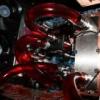Xbox 360:
Hardware Specs:
Custom IBM Power-PC Based CPU
* Three symmetrical cores running at 3.2 GHz each
* Two hardware threads per core; six hardware threads total
* VMX-128 vector unit per core; three total
* 128 VMX-128 registers per hardware thread
* 1 MB L2 cache
CPU Game Math Performance
* 9 billion dot product operations per second
Custom ATI Graphics Processor
* 500MHz processor
* 10 MB of embedded DRAM
* 48-way parallel floating-point dynamically scheduled shader pipelines
* Unified shader architecture
Polygon Performance
* 500 million triangles per second
Pixel Fill Rate
* 16 gigasamples per second fill rate using 4x MSAA
Shader Performance
* 48 billion shader operations per second
Memory
* 512 MB of GDDR3 RAM
* 700 MHz of DDR
* Unified memory architecture
Memory Bandwidth
* 22.4 GB/s memory interface bus bandwidth
* 256 GB/s memory bandwidth to EDRAM
* 21.6 GB/s front-side bus
Overall System Floating Point Performance
* 1 teraflop
Storage
* Detachable and upgradeable 20GB hard drive
* 12x dual-layer DVD-ROM
* Memory Unit support starting at 64 MB
I/O
* Support for up to four wireless game controllers
* Three USB 2.0 ports
* Two memory unit slots
Optimized for Online
* Instant, out-of-the-box access to Xbox Live features with broadband service, including Xbox Live Marketplace for downloadable content, gamer profile for digital identity, and voice chat to talk to friends while playing games, watching movies, or listening to music
* Built-in Ethernet port
* Wi-Fi ready: 802.11a, 802.11b, and 802.11g
* Video camera ready
Digital Media Support
* Support for DVD-Video, DVD-ROM, DVD-R/RW, DVD+R/RW, CD-DA, CD-ROM, CD-R, CD-RW, WMA CD, MP3 CD, JPEG Photo CD
* Ability to stream media from portable music devices, digital cameras and Windows XP-based PCs
* Ability to rip music to the Xbox 360 hard drive
* Custom playlists in every game
* Built-in Media Center Extender for Windows XP Media Center Edition 2005
* Interactive, full-screen 3-D visualizers
High-Definition Game Support
* All games supported at 16:9, 720p, and 1080i, anti-aliasing
* Standard-definition and high-definition video output supported
Audio
* Multi-channel surround sound output
* Supports 48KHz 16-bit audio
* 320 independent decompression channels
* 32-bit audio processing
* Over 256 audio channels
System Orientation
* Stands vertically or horizontally
Customizable Face Plates
* Interchangeable to personalize the console
Nintendo Wii:
Design Featuring a compact design that makes it a natural addition to any television setup, the Wii console is white in color and can be displayed either vertically or horizontally.
Size
About 8.5 inches long, 6 inches wide and less than 2 inches thick (roughly the size of 3 DVD cases stacked on top of each other).
Network
The Wii console communicates wirelessly with the Internet via wireless or a Wii LAN adaptor. Wii also can connect wirelessly with Nintendo DS.
CPU / GPU
PowerPC CPU (code-named “Broadway”), made with a 90nm SOI CMOS process, jointly developed with and manufactured by IBM; GPU developed with ATI.
Media
A single self-loading media bay plays single- or double-layered 12-cm optical discs for the Wii console, as well as 8-cm Nintendo GameCube discs.
Input / Output
Input: Four Wii Remotes can communicate with Wii, which features a bay for an SD memory card.
Output: An AV Multi-output port for component, composite or S-video.
WiiConnect24
The Wii console can communicate with the Internet even when the power is turned off. The WiiConnect24 service delivers a new surprise or game update, even if the system is idle. Users can connect wirelessly or by using a Wii LAN adaptor.
Playstation 3:
CPU: Cell Processor PowerPC-base Core @3.2GHz
--1 VMX vector unit per core
--512KB L2 cache
--7 x SPE @3.2GHz
--7 x 128b 128 SIMD GPRs
--7 x 256KB SRAM for SPE
--*1 of 8 SPEs reserved for redundancy
--Total floating point performance: 218 gigaflops
GPU RSX @ 550MHz
--1.8 TFLOPS floating point Performance
--Full HD (up to 1080p) x 2 channels
--Multi-way programmable parallel Floating point shader pipelines
--Sound Dolby 5.1ch, DTS, LPCM, etc. (Cell-based processing)
MEMORY
256MB XDR Main RAM @3.2GHz
256MB GDDR3 VRAM @700MHz
System Bandwidth Main RAM-- 25.6GB/s
VRAM--22.4GB/s
RSX-- 20GB/s (write) + 15GB/s (read)
SB2.5GB/s (write) + 2.5GB/s (read)
SYSTEM FLOATING POINT PERFORMANCE:
2 teraflops
STORAGE
--HDD Detachable 2.5" HDD slot x 1
--I/O--USB Front x 4, Rear x 2 (USB2.0)
--Memory Stickstandard/Duo, PRO x 1
--SD standard/mini x 1
--CompactFlash(Type I, II) x 1
COMMUNICATION
--Ethernet (10BASE-T, 100BASE-TX, 1000BASE-T) x 3 (input x 1 + output x 2)
--Wi-Fi IEEE 802.11 b/g
--Bluetooth--Bluetooth 2.0 (EDR)
--ControllerBluetooth (up to 7)
--USB 2.0 (wired)
--Wi-Fi (PSP)
--Network (over IP)
AV OUTPUT
Screen size 480i, 480p, 720p, 1080i, 1080p
HDMI out x 2
AV multi out x 1
Digital out (optical) x 1
DISC MEDIA
CD
PlayStation CD-ROM
PlayStation2 CD-ROM
CD-DA
CD-DA (ROM),
CD-R,
CD-RW
SACD Hybrid (CD layer),
SACD HD
DualDisc (audio side)
DualDisc (DVD side)
PlayStation 2 DVD-ROM
PlayStation 3 DVD-ROM
DVD-ROM
DVD-R
DVD-RW
DVD+R,
DVD+RW
Blu-ray Disc
PlayStation 3 BD-ROM
BD-ROM
BD
Geeks To Go whats the Pro/Cons of each system, and overall quality, based from Price, Specs, Pro vs. Cons.
Thank you,
Steven Soleimani (TechMan1000)

















 Sign In
Sign In Create Account
Create Account

